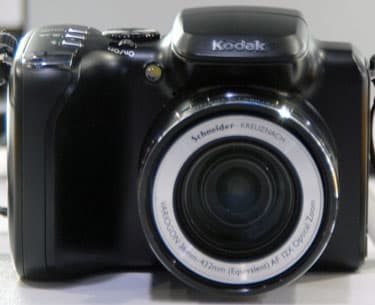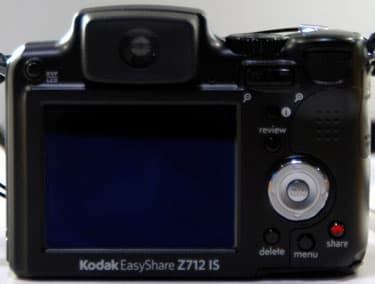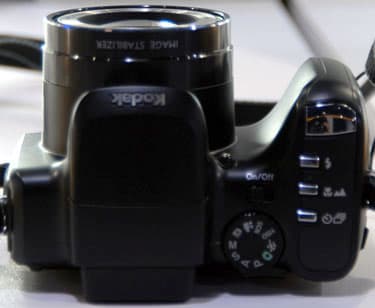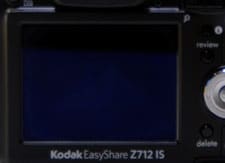Physical Tour
**Front
**The Kodak EasyShare 712 IS takes on the form of a standard digital camera in the sub-DSLR class, with its big, bulky handgrip/battery compartment, wide lens mount, and overhanging flash/viewfinder with "Kodak" printed on the front. The camera’s front façade is dominated by these elements, with the silver lens housing standing out against the black plastic of the rest of the body. The lens name and specs are printed on the front of the housing, and the words Image Stabilizer are on the top-facing part. Between the lens and the handgrip, on the upper left, is the self-timer/video/lowlight assist light. Between this and the lens is the one-hole microphone for sound recording.

**Back
**The back of the camera is busy. The viewfinder sits at the top, fitted with a square, black rubber eyecup that surrounds the round glass element. The LCD is directly below the viewfinder, with the camera’s name emblazoned in white below. To the left of the viewfinder, above the upper left corner of the LCD, is the EVF/LCD switch that allows the user to switch back and forth between the two. At the upper right, the mode dial’s edge protrudes above the zoom toggle switch which lies to the left of the jog dial. The jog dial can be turned to scroll through and select the exposure settings in manual modes. Directly below the zoom toggle switch are two buttons, stacked one atop the other. The first is the information/help button, symbolized by a small letter i. The second is the review button, which controls the record/playback selection. To the right of these buttons is the 12-dot thumb pad. Centered below these items is the circular 4-way controller, with each of the four arrows serving simply as directional controls for the screen views and the central OK button. Below this, at the bottom right of the camera back, are three buttons—menu, delete, and share, which allows users to tag pictures for printing, e-mail, and the favorites menu.

**Right Side
**The right side of the Z712 IS has just two items of note. The clip for the camera strap sits near the top of the side. The port door is a soft rubber cover hinged on the bottom that pulls back to reveal the DC/AV/USB connections.

**Left Side
**The left side of the camera contains only the clip that anchors the wrist strap and lens cap. Visible from this angle are the printed words "12x IS" on the lens barrel and '7.1 megapixels" on the camera body.

**Top
**The flash cover dominates the center of the EasyShare Z712’s top side. The left side contains no controls. The right top side holds six main control elements. The On/Off switch sits just to the right of the flash housing toward the front of the camera body. Directly behind this is the mode dial which contains a mix of letters and symbols to indicate the various shooting and playback modes. To the right of these are the controls that run along the battery grip. At the very front is the square-shaped, chrome shutter release button. Three small rectangular chrome buttons sit behind this—the flash, focus, and drive buttons.

**Bottom
**The door concealing the battery and media card slots is on the bottom beneath the camera grip. The camera’s tripod mount is to the right of this, and the camera dock connection is below that.

Components
**Viewfinder
**

The electronic viewfinder on the Z712 IS contains 230,000 pixels of resolution—a good count for composing images—the 100 percent coverage allows for full assessment of picture edges. This seemed pretty accurate on the show floor. However, the eye-cup for the viewfinder is awkward. It would have been beneficial if the cup extended out more from the camera body to keep your face from pressing against the LCD screen. There is plenty of information viewable in the EVF, such as mode, image size, aperture, shutter speed, ISO, frame number, exposure compensation, card or internal memory indicator, and a histogram. There’s a handy EVF/LCD switch button on the upper right that allows quick and easy switching between the two views.

**LCD Screen
**The Z712 has 115,000 pixels spread across its 2.5" TFT LCD, and it's not truly acceptable, although it's quite common on a compact camera. It's unfortunate that Kodak didn’t put more into the screen resolution, considering the camera’s design and target audience. Sure, the viewfinder has 230,000 pixels, but at a 7-megapixel image size, it would be nice to be able to review images at a decent resolution and get a better gauge of focus and details. Colors did not seem vibrant, and the resolution was poor. It’s easy to see why they didn’t provide 16x magnification for image review. The screen couldn’t handle it. However, the LCD’s angle of view was quite good, and there is a decent level of control available to users, including five setting levels for brightness and contrast.
**Flash
**The pop-up flash on the Z712 is a slim rectangle that is housed at the top of the camera. It pops up automatically when the flash is set to on, and since it’s so small, the housing doesn’t protrude too much from the camera body. Consequently, there shouldn’t be any problems with damaging the flash. The flash’s 1.6 to 5.4 feet range is decent. The flash coverage looked good for the wide-angle view, but the telephoto range (3.9 to 8.9 feet), will only do for close-up portraits, not for more distant views. It syncs at 140 ISO, so there should be little problem with noise when the flash is engaged. The flash settings are auto, red eye pre-flash, fill, and off.

**Zoom lens
**The Z712 boasts an optically stabilized Schneider Kreuznach Variogon lens, featuring a 12x, 6-72mm (equivalent to 36-432mm in 35mm format) optical zoom. The f-stop range, only f/2.8 to f/4.8, is poor for such a wide-angle range, so don’t expect to get decent landscapes from this one.

Barrel distortion was obvious at the wide-angle range and focus less crisp. Zoom response was slow and jumpy when the switch is released. We’ll be evaluating these specifics in the lab tests, as well as the Optical Image Stabilization performance.
Design / Layout
**Model Design/Appearance
**The Kodak Easy Share Z712 IS is a very lightweight camera, making it easy to carry and light around the neck. It adopts the standard design of other high-zoom digital cameras, but the plastic construction doesn’t seem very durable or capable of withstanding much abuse. However, the low weight might be appealing to Kodak’s target demographic: women. But, we’re betting that anyone who buys this type of camera is going to want something that at least feels more substantial and robust.
**Size/Portability
**The Z712’s size is right within the range of all the high-zoom, SLR-like compacts. It measures 4.1" x 2.9" x 2.7" and weighs 10.6 ounces. This makes it very portable and lightweight, even when hanging by the neck strap. By virtue of its shape and handling, it still gives the feel of mini SLR; however, as stated before, the all-plastic construction coupled with its lightweight doesn’t inspire confidence in the unit’s durability.
**Handling Ability
**The unit felt comfortable in the hand. The grip is substantial allowing for easy carrying and manipulation. The proximity of the LCD so near to the left side made finding a place for the left hand a bit awkward, as well as using the viewfinder. The eyecup fits so close to the body that it was easy to press your nose onto the LCD, thus clouding the view with grease.
**

Control Button/Dial Positioning/Size
The controls atop the camera were logically organized. They were easy to operate and spacing was good. The problem comes with the rear panel controls. The lens toggle switch is way too close to the mode dial, leaving fumbling fingers searching for it. Worst of all is the use of the focus switch when using the viewfinder. The switch presses against the side of the cheek, making it difficult for your finger to find and operate it. The toggle switch is easily located, but it is not the most intuitive of devices. In manual mode, you spin it to scroll over exposure options you see in the viewfinder or the LCD, press it to select the option, scroll again to select the specific setting, then press it again to select that option. The 4-way control is also poorly constructed, without enough physical distinction between arrow directions. It’s remarkably easy to inadvertently press one of the arrow dials when selecting the OK button. Even small fingers would have difficulty not hitting one button while trying to press another. This convolutes the shooting process and makes the camera more difficult to use effectively.
**MenuThe EasyShare Z712’s menus are very flashy—too flashy. They are very busy graphically and somewhat difficult to read. The non-intuitive menu structure and clustered display makes for an unpleasant experience. Like most camera menus, a particular item is selectable with the 4-way arrow buttons. But the Z712’s menu shows only the current setting, not the menu item itself. It's located at the title bar at the top of the menu stack, so you have to look back at the title bar to see where you are in the menu. Then you select the item by pressing OK, which brings you into the submenu of selectable options. Once you get the hang of navigation, it’s not too bad, but the design could be more intuitive – particularly for a brand that endlessly markets its ease of use.
Other than the basic modes, many of these settings were not explored but will be in the full review to come. The Playback settings listed here were not available on the preproduction model, but they were taken from the Kodak website.
**Ease of Use
**All of the major modes on the Z712 are accessed through the mode dial, and the other major functions—flash, drive, and focus—are accessed via the buttons near the shutter. Manual exposure settings are accessed in manual mode using the jog dial to select items on screen. Once you figure out the jog dial, changes are made easily enough, and it's certainly nice to have all the options displayed for you at once. But it’s unclear why there needs to be a separate dial when the 4-way control could serve as the selector for these functions, as it does on other cameras. Also, the crowded controls and menus make it awkward to use at times, particularly when using the viewfinder.
Modes
**Auto Mode
**Auto mode is truly auto, except for picture size, compression, color mode, and date stamp, so handing the Kodak EasyShare Z712 IS to a novice is possible without worrying about exposure settings. The camera utilizes Kodak’s Color Science Image Processing Chip, which apparently analyzes the image scene and selects the best Scene mode for exposure. It defaults to Auto if it can’t figure it out. The images produced on the show floor in this mode were well exposed and focused. Entering program mode gives the user exposure and flash compensation options.
**Movie Mode
**Two menus options are provided with Movie Mode on the Z712. Image resolution is selectable for VGA, 640 x 480, or QVGA, 320 x 240, both at 30 fps. Single or continuous focus can also be selected, so zoom is possible in movie mode, as is image stabilization. The only editing functions available are to extract still images from videos and trimming. The menu on the floor model was not complete, so testing of these features was not possible. Look for more information in the full review.
**Drive/Burst Mode
**The Kodak Z712 IS has several burst modes, all with a 2 fps rate, not great for a camera in this class. The self-timer options include two pictures, 2-second delay, and 10-second delay. The burst mode includes first burst and last burst, which take up to six frames.
**Playback Mode
**The playback modes were not available in the preproduction floor model, so the menu items below are taken directly from Kodak’s website. Most of the features, beyond simple review of images, could not be explored. Perfect Touch Technology was not available for us to preview on the preproduction model, so it will be explored in the full review.
**Custom Image Presets
**The custom Scene modes are accessed through the mode dial and are mostly standard fare for digital cameras.
Control Options
**Manual Control Options
**The Kodak Z712 IS offers a full manual mode, enabling users to set shutter speed and aperture. There are also priority modes for each. Z712 IS users can also set ISO and focus manually, though unfortunately, there is no way to manually set a white balance.
**Focus
***Auto Focus
*The Z712 has three options for selecting the zone of focus—Multi-zone, Center-zone, and Selectable zone—and two options for rate, continuous, or single. The default option is Multi-zone and this functioned well on the show floor. It responded well when focusing in close on an object, but it did have some problems with low light conditions.
*Manual Focus
*The manual focus option is controlled by entering the focus mode via the top focus button, then controlling focus with the 4-way wheel, which was slow and awkward. Focus jerked forward or back a little after releasing the button.
**Exposure
**There are many options to control exposure modes on the EasyShare Z712 IS, accessible in Program, Aperture Priority, Shutter Priority, and Manual modes. Manual mode lets you control all of them—aperture, shutter, exposure compensation, flash compensation, and ISO. Aperture and shutter priority modes let you control shutter and aperture, respectively, and program modes only allow settings of ISO, exposure and flash compensation.
**Metering
**The Z712 has three metering modes, multi-pattern, center-weighted, and spot. The multi-pattern is the default mode, and this performed well for most scenes, but bright images appeared somewhat washed out.
**White Balance
**The five available settings for white balance on the Z712 include auto, daylight, tungsten, fluorescent, and open shade. Unfortunately, no manual white balance settings were included. This will be a problem in mixed lighting conditions, though our initial impressions of the camera’s auto and fluorescent settings under the convention center lights were favorable.
**ISO
**ISO settings, like other exposure parameters, are set via the jog dial in the modes where it’s selectable. Settings start at 80, stopping at 100, and then progresses in full stops up to 3200, which is only available at a small, 1.2-megapixel image size. The auto setting appeared to read the lighting in the Convention Center correctly, while the High ISO mode on the mode dial engaged the 3200 speed ISO and was able to freeze the motion of passersby at the Kodak booth.
**Shutter Speed
**Shutter-speed ranges from 1/2 to 1/1000 second in 1/3-stop increments, which seems like a very narrow range for a camera in this class. There are even many compact cameras with a greater range.
**Aperture
**The aperture range on the Kodak Z712 IS extends from f/2.8 to f/4.8. This is a pretty limited range, particularly for models with decent wide-angle capabilities. It’s clear that this camera is meant for portrait or other close shooting.
Image Parameters
**Picture Quality/Size Options
**The EasyShare Z712 IS can produce images in various image sizes and aspect ratios, including 3072 x 2304, 3072 x 2048 (at 3:2 aspect ratio for 4" x 6" prints), 2592 x 1944, 2048 x 1536, 1800 x 1200 (at 3:2 aspect ratio), 1920 x 1080 (at 16:9 aspect ratio), and 1280 x 960 for e-mail and small prints.
**Picture Effects Mode
**The 712 has five color modes available to users, including High, Natural, Low, B/W, and Sepia, a menu similar to many cameras in this class on the market today.
Connectivity / Extras
**Connectivity
***

Software
*The Z712 ships with Kodak EasyShare software for both Mac and PC.
*Jacks, Ports, and Plugs
*Standard ports are included on the Z712, such as USB, DC, and AV. The bottom of the camera also features a Kodak-specific docking port to connect to their line of EasyShare printers.
*Direct Print Options
*Since this is a Kodak camera, the options for printing include the EasyShare printing system, for which an optional dock can be purchased to connect with a printer.
*Battery
*

Battery options include a standard CRV3 battery pack or a Kodak Li-ion battery pack, one of which is included with the camera upon purchase.
*Memory
*The Z712 IS’s internal memory includes 32 MB of memory, with 28 MB available for image storage. The camera also accepts SD and MMC media cards.
**Other Features
**Share button – The Share button on the rear control panel allows users to tag images for later printing and sharing. Pictures can be put into specific folders that the user creates using the Set Album option in the Set-Up menu.
Overall Impressions
**Value
**The $299 retail price for the Kodak EasyShare Z712 IS might make the camera more appealing than comparable high-zoom compacts that sell for more, but the limited aperture range, all-plastic body, crowded and poorly located controls, and bad menu design might push consumers to fork over the extra cash for a better quality camera.
**Who’s This Camera For?
***Point-and-Shooters –* The level of control would probably steer away those looking for a fully automatic camera, although, with its fully automatic mode, it might be a good camera to share with a family member who likes more manual controls.
*Budget Consumers – *This might be the camera to buy for those seeking an SLR-like compact, since it’s cheaper than many of the other options in this category. However, consumers should play with the controls first to make sure they work for them.
Gadget Freaks – Techies will probably shy away from the poorly designed controls and bad 4-way dial, but items like the extra jog dial, the Share button, and Perfect Touch Technology might entertain them.
Manual Control Freaks – Consumer shopping in this category might like the level of manual control and the way exposure settings are accessed, via the jog dial, but they also may question the need for an extra control.
Pro/Serious Amateurs – This group will likely find a better constructed camera to use for a back-up or vacation model.
Conclusion
**Conclusion
**In the increasingly crowded high-zoom, SLR-like digital camera market, consumers are faced with many options. These cameras offer the feel of an SLR in a smaller size with many automatic options. Some manufacturers are offering solid examples and are also constantly improving the category. While the Kodak EasyShare Z712 IS offers some new technologies, like Perfect Touch and their new Color Science Image Processing Chip, its major selling point is the price. If you want a high-zoom camera with a lightweight design at an affordable price, this camera will suffice. However, if you are drawn to this camera because of its "Easy" designation, don’t be fooled, most cameras in this category have a full auto mode and will function as a direct point and shoot. For those interested in the Z712 IS, it will likely serve your needs, it just may not provide as much control or the image quality of its competitors.
Photo Gallery
Meet the tester

Tom Warhol
Editor
Tom Warhol is a valued contributor to the Reviewed.com family of sites.
Checking our work.
Our team is here for one purpose: to help you buy the best stuff and love what you own. Our writers, editors, and lab technicians obsess over the products we cover to make sure you're confident and satisfied. Have a different opinion about something we recommend? Email us and we'll compare notes.
Shoot us an email